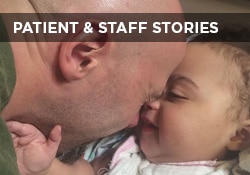This website uses cookies so that we can provide you with the best user experience possible. Cookie information is stored in your browser and performs functions such as recognising you when you return to our website and helping our team to understand which sections of the website you find most interesting and useful.

Susan E. Mazer, Ph.D. Blog
Thoughts and ideas on healthcare
Hi, and welcome to my blog! I'm Susan E. Mazer -- a knowledge expert and thought leader on how the environment of care impacts the patient experience. Topics I write about include safety, satisfaction, hospital noise, nursing, care at the bedside, and much more.
Nurse Burnout and the Patient Experience: The COVID Crush
October 1, 2021
Pat Linton, the founding CEO of North Hawaii Community Hospital, categorically stated that “The only difference between the patient and the caregiver is acuity.” What does that mean? Well, it means that whoever is standing next to the hospital bed could easily be in the bed in short order.
Covid-19 and its variants remind us that no one is truly immune or safe from illness. We are all human, and in our humanness, we are all vulnerable. We have felt this collective vulnerability worldwide, but some may argue our healthcare workers have faced much higher risks as they carry the burden of their patient’s health and their own, including their families, parents, and colleagues.
Even before Covid-19, clinicians often worked under conditions that ran counter to their professional standards of care and caring. They often worked in unsafe environments, being responsible for more patients than they could safely care for. Nurses hear about insufficiencies like not enough ventilators, not enough medication, not enough patient beds; there is not enough of anything. Now add staff members calling in sick and lack of support, which makes everything worse. All these factors create a perfect storm of burnout.
During Covid-19, the lack of staff, PPEs, feelings of inefficacy, and crowding on the unit, felt dehumanizing and unjust. The burnout rate was high even before Covid-19 started, with 50% for physicians and 33% for nurses. That rate has only increased.
Covid, Burnout, & The Environment
Recently the Hasting Center published an essay by Adrian Anzaldua and Jodi Halpern (2021), Can Clinical Empathy Survive? Distress, Burnout, and Malignant Duty in the Age of Covid-19. The authors carefully, and in detail, described the Covid environment and its impact on nurses and physicians in terms of ethics, professional commitment, inefficacy, and helplessness at the bedside.
Nurses and physicians, who themselves were and continue to be at risk, have tended to Covid patients with empathy they could barely offer to themselves. Not to be taken for granted, a nurse’s ability to be empathetic is dependent on several factors, including being able to practice and care for patients according to their own values and ethics. “The virtuous nature of [clinical] professionalism becomes a force that traps workers in clinical environments that undermine their ethical goals…” 1
What is “Burnout”?
Burnout, a term thrown around much too easily, “manifests with symptoms of emotional and physical exhaustion, feelings of professional inefficacy, and depersonalization, a sense of lost identity marked by feeling disconnected from one’s own thoughts and feelings.” These symptoms impact the long-term health of clinicians and the quality of care at the bedside. All of us (families, friends, neighbors) are affected to this day.
Patient safety is directly linked to nurse burnout. One of the main causes of burnout in nurses is an unsafe working environment. To a nurse, “unsafe” means having more patients to care for than they can effectively manage. Long hours, insufficient equipment (like PPEs), and a clear shared risk among both patients and providers contribute to burnout and dissatisfaction.

The Humanity of Our Healthcare System
Anzaldua and Halpern identify the tearing apart of the very humanity of our healthcare system as it ignores the often potent but invisible needs of those who care for all of us.
The process of “triage” forces choices that ask about patient needs, but not necessarily about the nurse’s needs. Remember, they are equal players in every hospitalization. What we expect and need from each nurse is not merely a “to-do list.”
Emotional presence is required to be empathetic; empathy can only be expressed when the individual has the internal freedom to do so. In Covid, there is no freedom, and empathy can only be hinted at. The oxygen needed to breathe caring into every patient has been taken up with panic and inadequate support.
At this time, Covid is spreading at a rate not seen for the last year. Right now, patient desperation is great and their needs are as critical. For the clinical staff, the struggle between ethical practice and barely meeting the demands of the moment has reached hazardous levels with no foreseeable relief.
Now, add in Hurricane Ida, the massive fires in the west, and drought.
Since March of 2020, we have been in a state of crisis, with events often changing by the hour. In 2021, we remain not in the same crisis, but a new crisis that starts with the exhaustion from the first one.
The question is what can be provided to relieve even a small piece of anxiety that lives in our hospitals?
Creating Change from Crisis
We can make small and meaningful changes in the patient-nurse environment. Even if there is little to no treatment for acute Covid-19 patients, hospitals can condition their environments for comfort. We learned this from the AIDS crisis, for which there were no treatments for years. Still, there is always something to do that will bring comfort.
Whether in a hospital room, emergency room, outpatient clinic, or during a telehealth appointment, the immediate environments on both sides of the relationship become a third player in the interaction.
When we focus on the shared environment, where care is delivered and received, there are immediate and clear tensions. For example, the nurse is in “working” mode; urgent, alert, caring for more than one patient who is demanding their attention. Conversely, the patient awaits care and needs human contact to feel safe and cared for. Further, the patient is sick enough to be in the hospital and has neither patience nor capacity.
Environmental stressors, such as noise, crowding, lighting, clutter, and other people, are experienced according to the acuity of the individual. The patient (any patient) has limited coping skills and limited bandwidth to adapt to hostile factors. The nurse (every nurse) is driven by professional goals, but as a human being, may not have much more space beyond having to make zero errors in their tasks.
Caregiver & Care-Receiver
How can we support both the patient and nurse while acknowledging that their respective needs may compete? By recognizing that everyone matters and the interdependence between caregiver and care-receiver is unyielding. More so, during Covid, patients have no support from family members. The nurses and physicians become “family” by proxy, having to provide physical and emotional support.
“Acting from duty is seldom necessary when workplace conditions permit the practice of clinical empathy, which provides professional motivation, meaning, and psychological protection. When clinical conditions do not permit the practice of clinical empathy, health care workers turn to their sense of obligation or duty to not abandon patients. Submitting to professional duty can protect some from psychological injury, for at least a while, but the chronic suppression of authentic reactions of outrage, fear, and grief that accompany submission to duty can further contribute to distress and burnout.”
I think about this every day. The “triage” process to determine who to care for first, who has a chance of surviving, or who might die if we do not act, is the story of Covid-19 since starting in March 2020.
Empathy, altruism, and deep caring mitigates much of human suffering, regardless of who is in a health crisis. Today, being forgiving, generous, and offering both compassion and empathy is more needed that ever. However, the Covid environment has put all of us in need of intensive caring.
In the almost 3 decades of producing The C.A.R.E. Channel, never has this environmental tool been more acknowledged and needed. We hear from staff and patients almost daily, letting us know how The C.AR.E. Channel has supported their patients and staff. Creating a peaceful and healing environment by elevating many of the environmental stressors that cause burnout.
Here are a few pieces of feedback we’ve received during the pandemic:
“I was recently hospitalized with Covid-19 for several days. I normally don’t bother with TV because I just don’t normally expect to find anything worth watching, but I hadn’t brought reading material since I hadn’t expected to be admitted. And so, as I nudged the channel button up a couple of times, I was greeted by a majestic mountain scene along with beautiful, jazz-inflected piano music that perfectly complemented the visual. I immediately left the channel button alone, and was able to mostly forget the unpleasant symptoms of the disease I was infected with. I was simply transported away from my suffering.”
“My wife was a patient. I stayed overnight with her. Covid is rampant and she was diagnosed with cancer. She has a great sense of humor. She will usually watch comedies. On this particular night she stopped at The C.A.R.E. Channel. It relaxed her, took her mind off the pain and discomfort and did not want to change the channel. We didn’t. Take care and stay safe.”
“I am in the hospital recovering from a bad Covid infection and the nurse recommended I try your program and relax at night to help fall asleep. I was totally impressed and surprised how effective it was.”
C.A.R.E.: One small change, changes everything.
A few short moments for you to breathe.
1 Adrian Anzaldua and Jodi Halpern, “Can Clinical Empathy Survive? Distress, Burnout, and Malignant Duty in the Age of Covid-19,” Hastings Center Report 51, no. 1 (2021): 22-27. DOI: 10.1002/hast.1216
https://pubmed.ncbi.nlm.nih.gov/33630324/
https://onlinelibrary.wiley.com/doi/full/10.1002/hast.1216










